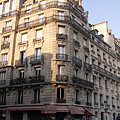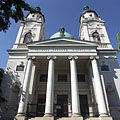(Ottimizzata per dispositivi di piccolo schermo)
Hungarian Parliament Building ("Országház") and surroundings - Budapest, Ungheria
Quando si fa clic:
Clicca sulle immagini!
-
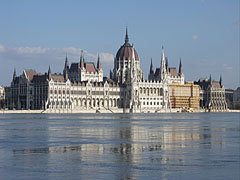
Hungarian Parliament Building (Országház)
Data di fotografia: 04/04/20062006
Creato da: Robert Németh
Modello di fotocamera: Konica Minolta Dimage A200
Budapest, Ungheria
-

The stunning building of the Hungarian Parliament (in Hungarian so called Országház) and River Danube in the light of the setting sun
Data di fotografia: 04/04/20062006
Creato da: Robert Németh
Modello di fotocamera: Konica Minolta Dimage A200
Budapest, Ungheria
-
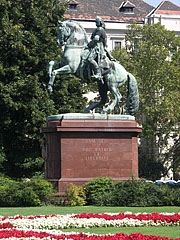
Statue of Francis II Rákóczi
Created by János Pásztor, it was inaugurated in 1937, on the 200th anniversary of the death of this Hungarian nobleman and prince.
Data di fotografia: 19/08/20092009
Creato da: Robert Németh
Modello di fotocamera: Konica Minolta Dimage A200
Budapest, Ungheria
-
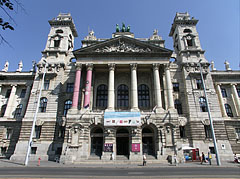
Palace of Justice (the major part of the building is used by the Hungarian Ethnographic Museum)
Data di fotografia: 19/08/20092009
Creato da: Robert Németh
Modello di fotocamera: Konica Minolta Dimage A200
Budapest, Ungheria
-
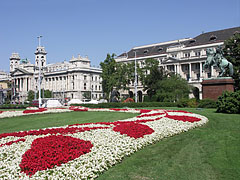
Flower carpet and green grass on the Kossuth Lajos Square
Data di fotografia: 19/08/20092009
Creato da: Robert Németh
Modello di fotocamera: Konica Minolta Dimage A200
Budapest, Ungheria
-

The Hungarian Parliament Building ("Országház") at night
Data di fotografia: 04/07/20172017
Creato da: Robert Németh
Modello di fotocamera: Konica Minolta Dimage A200
Budapest, Ungheria
-

The Hungarian Parliament Building (the Hungarian word "Országház") and River Danube by night
Data di fotografia: 04/07/20172017
Creato da: Robert Németh
Modello di fotocamera: Konica Minolta Dimage A200
Budapest, Ungheria
-
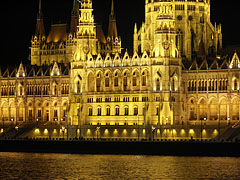
The Hungarian Parliament Building (in Hungarian "Országház") at night
Data di fotografia: 04/07/20172017
Creato da: Robert Németh
Modello di fotocamera: Konica Minolta Dimage A200
Budapest, Ungheria
-

The Hungarian Parliament Building ("Országház")
Data di fotografia: 15/07/20162016
Creato da: Robert Németh
Modello di fotocamera: Konica Minolta Dimage A200
Budapest, Ungheria
-

The Hungarian Parliament Building (the Hungarian word "Országház" means: "House of the Nation") and River Danube
Data di fotografia: 15/07/20162016
Creato da: Robert Németh
Modello di fotocamera: Konica Minolta Dimage A200
Budapest, Ungheria
-
The Hungarian Parliament Building (in Hungarian "Országház")
Data di fotografia: 15/07/20162016
Creato da: Robert Németh
Modello di fotocamera: Konica Minolta Dimage A200
Budapest, Ungheria
The Hungarian Parliament Building (in Hungarian "Országház") - Budapest, Ungheria -
The Hungarian Parliament Building ("Országház")
Data di fotografia: 15/07/20162016
Creato da: Robert Németh
Modello di fotocamera: Konica Minolta Dimage A200
Budapest, Ungheria
The Hungarian Parliament Building ("Országház") - Budapest, Ungheria -
The Hungarian Parliament Building ("Országház") viewed from Buda side of River Danube
Data di fotografia: 15/07/20162016
Creato da: Robert Németh
Modello di fotocamera: Konica Minolta Dimage A200
Budapest, Ungheria
The Hungarian Parliament Building ("Országház") viewed from Buda side of River Danube - Budapest, Ungheria -
The Hungarian Parliament Building ("Országház") and the Danube River, as seen from Buda
Data di fotografia: 15/07/20162016
Creato da: Robert Németh
Modello di fotocamera: Konica Minolta Dimage A200
Budapest, Ungheria
The Hungarian Parliament Building ("Országház") and the Danube River, as seen from Buda - Budapest, Ungheria -
The Hungarian Parliament Building ("Országház")
Data di fotografia: 03/06/20052005
Creato da: Robert Németh
Modello di fotocamera: Konica Minolta Dimage A200
Budapest, Ungheria
The Hungarian Parliament Building ("Országház") - Budapest, Ungheria -
The Hungarian Parliament Building (the Hungarian word "Országház" means: "House of the Nation")
Data di fotografia: 03/06/20052005
Creato da: Robert Németh
Modello di fotocamera: Konica Minolta Dimage A200
Budapest, Ungheria
The Hungarian Parliament Building (the Hungarian word "Országház" means: "House of the Nation") - Budapest, Ungheria -
The Hungarian Parliament Building (in Hungarian "Országház")
Data di fotografia: 03/06/20052005
Creato da: Robert Németh
Modello di fotocamera: Konica Minolta Dimage A200
Budapest, Ungheria
The Hungarian Parliament Building (in Hungarian "Országház") - Budapest, Ungheria -
The Hungarian Parliament Building ("Országház")
Data di fotografia: 02/05/20052005
Creato da: Robert Németh
Modello di fotocamera: Konica Minolta Dimage A200
Budapest, Ungheria
The Hungarian Parliament Building ("Országház") - Budapest, Ungheria -
The Hungarian Parliament Building ("Országház")
Data di fotografia: 03/06/20052005
Creato da: Robert Németh
Modello di fotocamera: Konica Minolta Dimage A200
Budapest, Ungheria
The Hungarian Parliament Building ("Országház") - Budapest, Ungheria -
The Hungarian Parliament Building ("Országház")
Data di fotografia: 03/06/20052005
Creato da: Robert Németh
Modello di fotocamera: Konica Minolta Dimage A200
Budapest, Ungheria
The Hungarian Parliament Building ("Országház") - Budapest, Ungheria -
The Hungarian Parliament Building ("Országház") and River Danube
Data di fotografia: 06/10/20042004
Creato da: Robert Németh
Modello di fotocamera: Canon PowerShot A85
Budapest, Ungheria
The Hungarian Parliament Building ("Országház") and River Danube - Budapest, Ungheria -
The Hungarian Parliament Building ("Országház") and River Danube
Data di fotografia: 06/10/20042004
Creato da: Robert Németh
Modello di fotocamera: Canon PowerShot A85
Budapest, Ungheria
The Hungarian Parliament Building ("Országház") and River Danube - Budapest, Ungheria -
The Hungarian Parliament Building, and the former Palace of Justice (on the left; today Ethnographic Museum) from the Danube at night
Data di fotografia: 20/10/20042004
Creato da: Robert Németh
Modello di fotocamera: Canon PowerShot A85
Budapest, Ungheria
The Hungarian Parliament Building, and the former Palace of Justice (on the left; today Ethnographic Museum) from the Danube at night - Budapest, Ungheria -
From left to right: the illuminated building of the Hungarian Parliament, the Buda Castle (Royal Palace) and the Chain Bridge over the Danube by night
Data di fotografia: 20/10/20042004
Creato da: Robert Németh
Modello di fotocamera: Canon PowerShot A85
Budapest, Ungheria
From left to right: the illuminated building of the Hungarian Parliament, the Buda Castle (Royal Palace) and the Chain Bridge over the Danube by night - Budapest, Ungheria -
Hungarian Parliament Building (Országház)
Data di fotografia: 04/04/20062006
Creato da: Robert Németh
Modello di fotocamera: Konica Minolta Dimage A200
Budapest, Ungheria
Hungarian Parliament Building (Országház) - Budapest, Ungheria -
Building of the Hungarian Parliament (Országház)
Data di fotografia: 04/04/20062006
Creato da: Robert Németh
Modello di fotocamera: Konica Minolta Dimage A200
Budapest, Ungheria
Building of the Hungarian Parliament (Országház) - Budapest, Ungheria -
The arcades of the Hungarian Parliament Building overlooking the River Danube at sunset
Data di fotografia: 04/04/20062006
Creato da: Robert Németh
Modello di fotocamera: Konica Minolta Dimage A200
Budapest, Ungheria
The arcades of the Hungarian Parliament Building overlooking the River Danube at sunset - Budapest, Ungheria -
Building of the Hungarian Parliament (Országház)
Data di fotografia: 04/04/20062006
Creato da: Robert Németh
Modello di fotocamera: Konica Minolta Dimage A200
Budapest, Ungheria
Building of the Hungarian Parliament (Országház) - Budapest, Ungheria -
The Hungarian Parliament Building viewed from the Danube River, during the great spring flood of 2006
A little father on the left the Palace of Justice ("Igazságügyi palota") can be seen.
Data di fotografia: 04/04/20062006
Creato da: Robert Németh
Modello di fotocamera: Konica Minolta Dimage A200
Budapest, Ungheria
The Hungarian Parliament Building viewed from the Danube River, during the great spring flood of 2006 - Budapest, Ungheria -
The southern facade of the Hungarian Parliament Building from the embankment (the crowd is watching an air race over River Danube)
Data di fotografia: 19/08/20092009
Creato da: Robert Németh
Modello di fotocamera: Konica Minolta Dimage A200
Budapest, Ungheria
The southern facade of the Hungarian Parliament Building from the embankment (the crowd is watching an air race over River Danube) - Budapest, Ungheria -
The view of the Hungarian Parliament Building from Buda
Data di fotografia: 08/10/20092009
Creato da: Robert Németh
Modello di fotocamera: Konica Minolta Dimage A200
Budapest, Ungheria
The view of the Hungarian Parliament Building from Buda - Budapest, Ungheria -
The cleaning and restoration of the Danube-side facade of the Hungarian Parliament Building was fully completed in 2009 (viewed from the Batthyány Square)
Data di fotografia: 08/10/20092009
Creato da: Robert Németh
Modello di fotocamera: Konica Minolta Dimage A200
Budapest, Ungheria
The cleaning and restoration of the Danube-side facade of the Hungarian Parliament Building was fully completed in 2009 (viewed from the Batthyány Square) - Budapest, Ungheria -
The Hungarian Parliament Building ("Országház") and the Danube River, viewed from the Batthyány Square
Data di fotografia: 08/10/20092009
Creato da: Robert Németh
Modello di fotocamera: Konica Minolta Dimage A200
Budapest, Ungheria
The Hungarian Parliament Building ("Országház") and the Danube River, viewed from the Batthyány Square - Budapest, Ungheria -
The statue (more precisely sculptural group) of Lajos Kossuth Hungarian statesman (created in 1952), and the Palace of Justice
Data di fotografia: 03/04/20062006
Creato da: Robert Németh
Modello di fotocamera: Konica Minolta Dimage A200
Budapest, Ungheria
The statue (more precisely sculptural group) of Lajos Kossuth Hungarian statesman (created in 1952), and the Palace of Justice - Budapest, Ungheria -
Kossuth Lajos memorial, the pedestal is made of red sandstone from Balatonalmádi
The main figure was created by Zsigmond Kisfaludi Strobl, and the other figures by András Kocsis and Lajos Ungvári, the statue was erected in 1952.
Data di fotografia: 03/04/20062006
Creato da: Robert Németh
Modello di fotocamera: Konica Minolta Dimage A200
Budapest, Ungheria
Kossuth Lajos memorial, the pedestal is made of red sandstone from Balatonalmádi - Budapest, Ungheria -
The Palace of Justice (in Hunagarian "Igazságügyi palota"), including the Ethnographic Museum
Data di fotografia: 03/04/20062006
Creato da: Robert Németh
Modello di fotocamera: Konica Minolta Dimage A200
Budapest, Ungheria
The Palace of Justice (in Hunagarian "Igazságügyi palota"), including the Ethnographic Museum - Budapest, Ungheria -
Equestrian statue (a man on a horse) of Francis II Rákóczi (in Hungarian "II. Rákóczi Ferenc") Hungarian aristocrat
Data di fotografia: 03/04/20062006
Creato da: Robert Németh
Modello di fotocamera: Konica Minolta Dimage A200
Budapest, Ungheria
Equestrian statue (a man on a horse) of Francis II Rákóczi (in Hungarian "II. Rákóczi Ferenc") Hungarian aristocrat - Budapest, Ungheria -
The southern facade of the Hungarian Parliament Building
Data di fotografia: 03/04/20062006
Creato da: Robert Németh
Modello di fotocamera: Konica Minolta Dimage A200
Budapest, Ungheria
The southern facade of the Hungarian Parliament Building - Budapest, Ungheria -
Neo-gothic motifs on the Hungarian Parliament Building (in Hungarian "Országház")
Data di fotografia: 03/04/20062006
Creato da: Robert Németh
Modello di fotocamera: Konica Minolta Dimage A200
Budapest, Ungheria
Neo-gothic motifs on the Hungarian Parliament Building (in Hungarian "Országház") - Budapest, Ungheria -
The southern facade of the Hungarian Parliament Building with the swollen (flooding) Danube River
Data di fotografia: 03/04/20062006
Creato da: Robert Németh
Modello di fotocamera: Konica Minolta Dimage A200
Budapest, Ungheria
The southern facade of the Hungarian Parliament Building with the swollen (flooding) Danube River - Budapest, Ungheria -
The Hungarian Parliament Building in springtime
Data di fotografia: 03/04/20062006
Creato da: Robert Németh
Modello di fotocamera: Konica Minolta Dimage A200
Budapest, Ungheria
The Hungarian Parliament Building in springtime - Budapest, Ungheria -
The dome of the Hungarian Parliament Building (in Hungarian "Országház" or "Parlament")
Data di fotografia: 03/04/20062006
Creato da: Robert Németh
Modello di fotocamera: Konica Minolta Dimage A200
Budapest, Ungheria
The dome of the Hungarian Parliament Building (in Hungarian "Országház" or "Parlament") - Budapest, Ungheria -
The southern side of the Hungarian Parliament Building (in Hungarian "Országház")
Data di fotografia: 03/04/20062006
Creato da: Robert Németh
Modello di fotocamera: Konica Minolta Dimage A200
Budapest, Ungheria
The southern side of the Hungarian Parliament Building (in Hungarian "Országház") - Budapest, Ungheria -
The facade of the southern wing of the Hungarian Parliament Building
Data di fotografia: 02/08/20072007
Creato da: Robert Németh
Modello di fotocamera: Konica Minolta Dimage A200
Budapest, Ungheria
The facade of the southern wing of the Hungarian Parliament Building - Budapest, Ungheria -
The Hungarian Parliament Building in Kossuth Square
Data di fotografia: 02/08/20072007
Creato da: Robert Németh
Modello di fotocamera: Konica Minolta Dimage A200
Budapest, Ungheria
The Hungarian Parliament Building in Kossuth Square - Budapest, Ungheria -
The Nagy Imre Memorial, created by Tamás Varga
Data di fotografia: 02/08/20072007
Creato da: Robert Németh
Modello di fotocamera: Konica Minolta Dimage A200
Budapest, Ungheria
The Nagy Imre Memorial, created by Tamás Varga - Budapest, Ungheria -
Statue of Imre Nagy former prime minister
Data di fotografia: 02/08/20072007
Creato da: Robert Németh
Modello di fotocamera: Konica Minolta Dimage A200
Budapest, Ungheria
Statue of Imre Nagy former prime minister - Budapest, Ungheria -
A nice corner building
Data di fotografia: 19/08/20092009
Creato da: Robert Németh
Modello di fotocamera: Konica Minolta Dimage A200
Budapest, Ungheria
A nice corner building - Budapest, Ungheria -
A typical view of the Alkotmány Street
Data di fotografia: 19/08/20092009
Creato da: Robert Németh
Modello di fotocamera: Konica Minolta Dimage A200
Budapest, Ungheria
A typical view of the Alkotmány Street - Budapest, Ungheria -
The tower of a residental building with luxury apartments
Data di fotografia: 19/08/20092009
Creato da: Robert Németh
Modello di fotocamera: Konica Minolta Dimage A200
Budapest, Ungheria
The tower of a residental building with luxury apartments - Budapest, Ungheria -
Honvéd Center office building
Data di fotografia: 19/08/20092009
Creato da: Robert Németh
Modello di fotocamera: Konica Minolta Dimage A200
Budapest, Ungheria
Honvéd Center office building - Budapest, Ungheria -
Honvéd Center office building
Data di fotografia: 19/08/20092009
Creato da: Robert Németh
Modello di fotocamera: Konica Minolta Dimage A200
Budapest, Ungheria
Honvéd Center office building - Budapest, Ungheria -
Kossuth Lajos memorial
Data di fotografia: 19/08/20092009
Creato da: Robert Németh
Modello di fotocamera: Konica Minolta Dimage A200
Budapest, Ungheria
Kossuth Lajos memorial - Budapest, Ungheria -
Statue of Lajos Kossuth
Data di fotografia: 19/08/20092009
Creato da: Robert Németh
Modello di fotocamera: Konica Minolta Dimage A200
Budapest, Ungheria
Statue of Lajos Kossuth - Budapest, Ungheria -
The Goddess of Justice with a three-horse chariot (triga) on the top, as well as the "Court Hearing" stone statue group within the tympanum on the facade of the Hungarian Ethnographic Museum
The statues were created in 1896, the former by Károly Senyei and the latter by György Zala.
Data di fotografia: 19/08/20092009
Creato da: Robert Németh
Modello di fotocamera: Konica Minolta Dimage A200
Budapest, Ungheria
The Goddess of Justice with a three-horse chariot (triga) on the top, as well as the "Court Hearing" stone statue group within the tympanum on the facade of the Hungarian Ethnographic Museum - Budapest, Ungheria -
Park on the Kossuth Square (the statue of Kossuth Lajos, the Palace of Justice and a yellow tram also can be seen)
Data di fotografia: 19/08/20092009
Creato da: Robert Németh
Modello di fotocamera: Konica Minolta Dimage A200
Budapest, Ungheria
Park on the Kossuth Square (the statue of Kossuth Lajos, the Palace of Justice and a yellow tram also can be seen) - Budapest, Ungheria -
Statue of Lajos Kossuth Hungarian politician
Data di fotografia: 19/08/20092009
Creato da: Robert Németh
Modello di fotocamera: Konica Minolta Dimage A200
Budapest, Ungheria
Statue of Lajos Kossuth Hungarian politician - Budapest, Ungheria -
Ethernal flame, commemorating the revolutionaries of the 1956 uprising against the Stalinist dictatorship and the Soviet occupation
Made of black marble by Mária Lugossy in 1996
Data di fotografia: 19/08/20092009
Creato da: Robert Németh
Modello di fotocamera: Konica Minolta Dimage A200
Budapest, Ungheria
Ethernal flame, commemorating the revolutionaries of the 1956 uprising against the Stalinist dictatorship and the Soviet occupation - Budapest, Ungheria -
Tourist are waiting to enter the Hungarian Parliament Building
Data di fotografia: 19/08/20092009
Creato da: Robert Németh
Modello di fotocamera: Konica Minolta Dimage A200
Budapest, Ungheria
Tourist are waiting to enter the Hungarian Parliament Building - Budapest, Ungheria -
Bronze statue of a lion at the main entrance of the Hungarian Parliament Building ("Országház")
Data di fotografia: 19/08/20092009
Creato da: Robert Németh
Modello di fotocamera: Konica Minolta Dimage A200
Budapest, Ungheria
Bronze statue of a lion at the main entrance of the Hungarian Parliament Building ("Országház") - Budapest, Ungheria -
The main door of the Hungarian Parliament Building (in Hungarian "Országház")
Data di fotografia: 19/08/20092009
Creato da: Robert Németh
Modello di fotocamera: Konica Minolta Dimage A200
Budapest, Ungheria
The main door of the Hungarian Parliament Building (in Hungarian "Országház") - Budapest, Ungheria -
The main door of the Hungarian Parliament Building (in Hungarian "Országház")
Data di fotografia: 19/08/20092009
Creato da: Robert Németh
Modello di fotocamera: Konica Minolta Dimage A200
Budapest, Ungheria
The main door of the Hungarian Parliament Building (in Hungarian "Országház") - Budapest, Ungheria -
The south-eastern facade of the Hungarian Parliament Building (in Hungarian "Országház")
Data di fotografia: 19/08/20092009
Creato da: Robert Németh
Modello di fotocamera: Konica Minolta Dimage A200
Budapest, Ungheria
The south-eastern facade of the Hungarian Parliament Building (in Hungarian "Országház") - Budapest, Ungheria -
Formerly the Palace of Justice ("Igazságügyi palota") was the home of the Royal Supreme Court of Justice, today the Hungarian Ethnographic Museum can be found in it
Data di fotografia: 19/08/20092009
Creato da: Robert Németh
Modello di fotocamera: Konica Minolta Dimage A200
Budapest, Ungheria
Formerly the Palace of Justice ("Igazságügyi palota") was the home of the Royal Supreme Court of Justice, today the Hungarian Ethnographic Museum can be found in it - Budapest, Ungheria -
The eastern facade of the Hungarian Parliament Building ("Országház")
Data di fotografia: 19/08/20092009
Creato da: Robert Németh
Modello di fotocamera: Konica Minolta Dimage A200
Budapest, Ungheria
The eastern facade of the Hungarian Parliament Building ("Országház") - Budapest, Ungheria -
The south-eastern facade of the Hungarian Parliament Building ("Országház")
Data di fotografia: 19/08/20092009
Creato da: Robert Németh
Modello di fotocamera: Konica Minolta Dimage A200
Budapest, Ungheria
The south-eastern facade of the Hungarian Parliament Building ("Országház") - Budapest, Ungheria -
Lush lawn and flower carpet in front of the Hungarian Parliament Building
Data di fotografia: 19/08/20092009
Creato da: Robert Németh
Modello di fotocamera: Konica Minolta Dimage A200
Budapest, Ungheria
Lush lawn and flower carpet in front of the Hungarian Parliament Building - Budapest, Ungheria -
Landscaped area also at the southern side of the Hungarian Parliament Building
Data di fotografia: 19/08/20092009
Creato da: Robert Németh
Modello di fotocamera: Konica Minolta Dimage A200
Budapest, Ungheria
Landscaped area also at the southern side of the Hungarian Parliament Building - Budapest, Ungheria -
The arcades of the Hungarian Ministry of Agriculture and Rural Development building
Data di fotografia: 23/08/20132013
Creato da: Robert Németh
Modello di fotocamera: Konica Minolta Dimage A200
Budapest, Ungheria
The arcades of the Hungarian Ministry of Agriculture and Rural Development building - Budapest, Ungheria -
The foyer (entrance hall) of the Hungarian Ethnographic Museum
Data di fotografia: 23/08/20132013
Creato da: Robert Németh
Modello di fotocamera: Konica Minolta Dimage A200
Budapest, Ungheria
The foyer (entrance hall) of the Hungarian Ethnographic Museum - Budapest, Ungheria -
The lobby (or foyer, entrance hall) of the Hungarian Ethnographic Museum
Data di fotografia: 23/08/20132013
Creato da: Robert Németh
Modello di fotocamera: Konica Minolta Dimage A200
Budapest, Ungheria
The lobby (or foyer, entrance hall) of the Hungarian Ethnographic Museum - Budapest, Ungheria -
The facade of the Palace of Justice, with the entrance of the Hungarian Ethnographic Museum
Data di fotografia: 23/08/20132013
Creato da: Robert Németh
Modello di fotocamera: Konica Minolta Dimage A200
Budapest, Ungheria
The facade of the Palace of Justice, with the entrance of the Hungarian Ethnographic Museum - Budapest, Ungheria -
A huge mound of earth in the middle of the main square of Budapest, the Kossuth Square in front of the Hungarian Parliament Building is undergoing a makeover
Data di fotografia: 23/08/20132013
Creato da: Robert Németh
Modello di fotocamera: Konica Minolta Dimage A200
Budapest, Ungheria
A huge mound of earth in the middle of the main square of Budapest, the Kossuth Square in front of the Hungarian Parliament Building is undergoing a makeover - Budapest, Ungheria -
Building operations in the Kossuth Square, the renovation of the facade of the Hungarian Parliament Building is just finished, and the paving of the street is undergoing a makeover as well
Data di fotografia: 23/08/20132013
Creato da: Robert Németh
Modello di fotocamera: Konica Minolta Dimage A200
Budapest, Ungheria
Building operations in the Kossuth Square, the renovation of the facade of the Hungarian Parliament Building is just finished, and the paving of the street is undergoing a makeover as well - Budapest, Ungheria -
(Re)construction works in the Kossuth Square (or Kossuth Lajos Square), and the main entrance of the Hungarian Parliament Building ("Országház") can be seen ahead
Data di fotografia: 23/08/20132013
Creato da: Robert Németh
Modello di fotocamera: Konica Minolta Dimage A200
Budapest, Ungheria
(Re)construction works in the Kossuth Square (or Kossuth Lajos Square), and the main entrance of the Hungarian Parliament Building ("Országház") can be seen ahead - Budapest, Ungheria -
Ongoing reconstruction works in the Kossuth Square
Although for some reason the target is to restore the state of 1944 of the square, of course this could be true only considering the overall alignment and some larger statues, because for example there was no visitor center in the Kossuth Square in 1944.
Data di fotografia: 23/08/20132013
Creato da: Robert Németh
Modello di fotocamera: Konica Minolta Dimage A200
Budapest, Ungheria
Ongoing reconstruction works in the Kossuth Square - Budapest, Ungheria -
Ongoing construction in the Kossuth Square
Data di fotografia: 23/08/20132013
Creato da: Robert Németh
Modello di fotocamera: Konica Minolta Dimage A200
Budapest, Ungheria
Ongoing construction in the Kossuth Square - Budapest, Ungheria -
Construction works in the Kossuth Square (or Kossuth Lajos Square) in front of the Hungarian Parliament Building
Data di fotografia: 23/08/20132013
Creato da: Robert Németh
Modello di fotocamera: Konica Minolta Dimage A200
Budapest, Ungheria
Construction works in the Kossuth Square (or Kossuth Lajos Square) in front of the Hungarian Parliament Building - Budapest, Ungheria -
During the reconstruction of the Kossuth Square the tram track were also renovated, and just a few old trees remained
Data di fotografia: 23/08/20132013
Creato da: Robert Németh
Modello di fotocamera: Konica Minolta Dimage A200
Budapest, Ungheria
During the reconstruction of the Kossuth Square the tram track were also renovated, and just a few old trees remained - Budapest, Ungheria -
Building operations in the main square in front of the Hungarian Parliament Building, as seen from the entrance of the "Palace of Justice" (Ethnographic Museum)
Data di fotografia: 23/08/20132013
Creato da: Robert Németh
Modello di fotocamera: Konica Minolta Dimage A200
Budapest, Ungheria
Building operations in the main square in front of the Hungarian Parliament Building, as seen from the entrance of the "Palace of Justice" (Ethnographic Museum) - Budapest, Ungheria -
The reconstruction of the square and the tram tracks are in progress in front of the "Palace of Justice" building
In 2013 the Palace of Justice ("Igazságügyi Palota") building is used by the Ethnographic Museum, until 1949 it was the Hungarian Royal Supreme Court ("Magyar Királyi Kúria"). Today (in 2015) it is used again by the Supreme Court (that is also called "Kúria"), together with the museum.
Data di fotografia: 23/08/20132013
Creato da: Robert Németh
Modello di fotocamera: Konica Minolta Dimage A200
Budapest, Ungheria
The reconstruction of the square and the tram tracks are in progress in front of the "Palace of Justice" building - Budapest, Ungheria -
Ongoing construction works in the Kossuth Square
This was the location of the former statue of Lajos Kossuth (which was created by Zsigmond Kisfaludi Strobl), together with a lot of big trees, unfortunately there's almost no any trace of them today.
Data di fotografia: 23/08/20132013
Creato da: Robert Németh
Modello di fotocamera: Konica Minolta Dimage A200
Budapest, Ungheria
Ongoing construction works in the Kossuth Square - Budapest, Ungheria -
As part of the revitalisation of the Kossuth Square the tram track was also renewed, the car traffic was bypassed and the main square became a car-free zone
Data di fotografia: 23/08/20132013
Creato da: Robert Németh
Modello di fotocamera: Konica Minolta Dimage A200
Budapest, Ungheria
As part of the revitalisation of the Kossuth Square the tram track was also renewed, the car traffic was bypassed and the main square became a car-free zone - Budapest, Ungheria -
At the north side of the Hungarian Parliament Building under the square an underground car park and a visitor center was developed
Data di fotografia: 23/08/20132013
Creato da: Robert Németh
Modello di fotocamera: Konica Minolta Dimage A200
Budapest, Ungheria
At the north side of the Hungarian Parliament Building under the square an underground car park and a visitor center was developed - Budapest, Ungheria -
Some of the surrounding streets were also included in the renovation of the Kossuth Square
Data di fotografia: 23/08/20132013
Creato da: Robert Németh
Modello di fotocamera: Konica Minolta Dimage A200
Budapest, Ungheria
Some of the surrounding streets were also included in the renovation of the Kossuth Square - Budapest, Ungheria
Clicca sulle immagini!
Caratteristiche, proprietà
Posizione:
Coordinate GPS: Latitudine 47°30'25", Longitudine 19°2'44" (N47 30.42 - E19 2.73)
Informazioni, racconti brevi, fatti interessanti
 The stunning building of the Hungarian Parliament (in Hungarian so called Országház) and River Danube in the light of the setting sun
The stunning building of the Hungarian Parliament (in Hungarian so called Országház) and River Danube in the light of the setting sun
In 2000 the central dome hall of the Hungarian Parliament Building ("Országház") became the depository and exhibition site of the Coronation Regalia (Crown Jewels) of Hungary, including the Hungarian Holy Crown, the sceptre, the cross-bearing orb (globus cruciger) and the coronation sword, but except the coronation mantle. The site can be visited by guided tour. Formerly the crown jewels could be watched in the Hungarian National Museum ("Magyar Nemzeti Múzeum").
 Hungarian Parliament Building (Országház)
Hungarian Parliament Building (Országház)
The Hungarian Parliament Building ("Országház") in numbers: 268 meters long, 123 meters wide and 96 meters high; the built-up floor space is 17 745 squaremeters, including more than 200 office rooms, 27 gates, 29 staircases, 10 inner courtyards (patios) and 13 elevators; there were used about 40 million bricks and half a million decorative stones for the construction; in addition about 40 kilograms of 22-23 carat gold plate, as well as outside 90 and inside 152 magnificent statues were used for the decoration.
 Building of the Hungarian Parliament (Országház)
Building of the Hungarian Parliament (Országház)
The Hungarian Parliament Building (in Hungarian "Országház") is the second largest parliament building in Europe, immediately after the Romanian Parliament Building that was completed in 1997. Globally just the Chinese Parliament Building is ahead both of them, at least in terms of size.
 The view of the Hungarian Parliament Building from Buda
The view of the Hungarian Parliament Building from Buda
The Hungarian Parliament Building or "Országház" was built between 1885-1894 by Hungarian architects led by Imre Steindl, as well as Hungarian engineers, master builders and workers, using materials only from Hungary. Nevertheless there was one exception: the eight 6-meter-tall unique marble monolithic columns at the grand staircase were brought here from Sweden.It took 2 years to create the foundation and the other earthworks, then during the following 8 years approximately 35 000 cubic meters of stones were carved and fitted into the facades of the palace, that was a lot of work in such a short time. Due to this it was decided to use such relatively soft stone material which was easy to work with, but the disadvantages appeared just after few decades as well. At around the 1920s the time had come the do the exterior renovation.
Both the World Wars and the Hungarian Revolution of 1956 caused serious damages in the Parliament Building of Budapest. The World War II alone resulted at least 250 mortar hits and 300 bomb hits! But thanks to the work of the many professionals for today nothing can be seen from it on the building, it shines in its original splendor inside and outside.
 The cleaning and restoration of the Danube-side facade of the Hungarian Parliament Building was fully completed in 2009 (viewed from the Batthyány Square)
The cleaning and restoration of the Danube-side facade of the Hungarian Parliament Building was fully completed in 2009 (viewed from the Batthyány Square)
Although the almost 100 kinds of sandstone which were used for the construction of the Hungarian Parliament Building ("Országház") were great for carving, soon the stones began to erode and crumble. This is why the professionals of the reconstructions (which were started in 1948) decided to rebuild the whole facade of the palace using a new material, the very durable and attractive white freshwater limestone from Süttő.
Süttő is a village in Northern Hungary halfway between Esztergom and Komárom towns, its mines were already existed 2000 years ago, at the time of the ancient Roman Empire. The decorative white Süttő limestone was formed in lukewarm freshwater springs and lakes about 1.8 million years ago in the Pleistocene epoch. Durable, hard, cold-resistant and relatively easy to work with it, probably this is why it was already used centuries ago in the middle ages to build renaissance palaces (for example at the time of King Matthias Corvinus). The sometimes in everyday language used "Süttő Marble" not a true marble, but just a pale maroon or beige colored limestone.
Good to know that in the current territory of Hungary there are no any true marble rocks, therefore the "Siklós Marble" and the "Piszke Marble" are also just a kind of solid and dense limestones. Even though the marble is also a kind of limestone, but as it is defined it has to contain larger crystals and at least 50 percent of carbonate minerals (calcite or dolomite), because that causes the gloss of polished marble.
 The Hungarian Parliament Building ("Országház") and the Danube River, viewed from the Batthyány Square
The Hungarian Parliament Building ("Országház") and the Danube River, viewed from the Batthyány Square
After many years in 2009 the moment has finally come when the western facade of the Hungarian Parliament Building ("Országház") is completely cleaned and restored, and the building proudly stands over the Danube without any scaffoldings. This is a big deal, because during many last decades the Parliament Building was almost always at least partially covered with scaffoldings, and also the ravages of time could be seen on the walls.
The renovation of the facades became necessary already in 1920, also a parliamentary decision was taken concerning this. In reality the renovation of the Hungarian Parliament Building was started in 1948 and lasted until the present days. In doing so, the dirty gray-black walls were entirely replaced and covered with the white Süttő (or Sutto) limestone by the building contractor Reneszánsz Kőfaragó Zrt. (Reneszansz Stone Inc.) and its legal predecessor the Állami Kőfaragó Vállalat ("State Stonemason Company").
Later, due to additional works scaffoldings were raised again on the northern and eastern facades. The complete renovation was finished at the end of 2013, 75 percent of the covering stones of the Parliament Building were replaced, so practically every outer walls of the palace were rebuilt. The builder actually demolished the smaller towers and turrets beside the dome then rebuilt them from newly-carved limestone elements. This work alone took 2.5 years per tower, but supposedly it doesn't need to renovate the facades even in the next 400 years (and hopefully there won't be any war which could destroy it again).
In 2013 the big renovations were continued with the Kossuth Square, most of its area was closed due to this. These works were completed in mid-2014.
 The statue (more precisely sculptural group) of Lajos Kossuth Hungarian statesman (created in 1952), and the Palace of Justice
The statue (more precisely sculptural group) of Lajos Kossuth Hungarian statesman (created in 1952), and the Palace of Justice
The original statue of Lajos Kossuth was inaugurated by regent Miklós Horthy in 1927, and at the same time the square got its current name. That monument stood here until 1952, when it was replaced by another Kossuth memorial, as well as the original statue was moved to Dombóvár town and placed in a park, in a different alignment. Although that monument received a lot of criticism due to its melancholic atmosphere both today and in the past, during the renovations of 2013-2014 for some reason this statue was erected again in the square, more precisely the resculpted version. At the same time the previous statue that was created in 1952 was removed from here, it is planned to set it up at the edge of the Prímás Island in Esztergom town.
Quite surprising, but in the first half of the 19th century there was only a landfill site (dumping ground) on this place. The filling of the pit and the area was started just in the middle of the 19th century, those times the name of the public place was "Tömő tér" (literally aproximately "Filling Square") which referred exactly to this.
 The Palace of Justice (in Hunagarian "Igazságügyi palota"), including the Ethnographic Museum
The Palace of Justice (in Hunagarian "Igazságügyi palota"), including the Ethnographic Museum
The current building of the Hungarian Ethnographic Museum ("Magyar Néprajzi Múzeum") was built between 1893-1896 in eclectic style, designed by Alajos Hauszmann. Formerly it was the Hungarian Royal Supreme Court or Palace of Justice (in Hungarian "Magyar Királyi Kúria" or "Igazságügyi Palota") until 1949. The museum is within its walls since 1973. There is a mural on the ceiling of the stateful main hall, it is called the "Triumph of Justitia", painted by Károly Lotz in 1895.
 Equestrian statue (a man on a horse) of Francis II Rákóczi (in Hungarian "II. Rákóczi Ferenc") Hungarian aristocrat
Equestrian statue (a man on a horse) of Francis II Rákóczi (in Hungarian "II. Rákóczi Ferenc") Hungarian aristocrat
The Rákóczi statue was created by János Pásztor sculptor and Dénes Györgyi architect, inaugurated in 1937. Although this equestrian statue of Francis II Rákóczi (in Hungarian "II. Rákóczi Ferenc") was created for the 200th anniversary of the death of the Hungarian nobleman and ruling prince, in reality the anniversary was not in 1937 but in 1935, as the caption on the pedestal also says.
 The Nagy Imre Memorial, created by Tamás Varga
The Nagy Imre Memorial, created by Tamás Varga
There is a statue in the Kossuth Square in Budapest, representing Imre Nagy former Hungarian prime minister, who was executed after the Hungarian Revolution of 1956 in 1958. This is the first full-figure statue of him in Hungary, created by Tamás Varga in 1996. The memorial monument consists of an arched bridge and the life-size bronze male figure who is standing on it and looking towards the Hungarian Parliament Building. The statue is standing exactly on the site of the former memorial of the victims of the Hungarian Soviet Republic of 1919 (the "Tanácsköztársaság" and the so-called Red Terror of the communists), which was demolished in 1945.
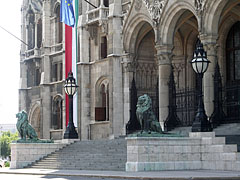 The main door of the Hungarian Parliament Building (in Hungarian "Országház")
The main door of the Hungarian Parliament Building (in Hungarian "Országház")
There are guarding bronze lion statues on both sides of the stairs at main entrance of the Hungarian Parliament Building ("Országház") on the Kossuth Square. Maybe it is surprising but these are artworks of two different artists. Of course it has a very simple reason. The lion on the left is original, created by Béla Markup sculptor in 1902. The original right side lion was also created by this sculptor, but it was damaged in the WWII therefore a new one had to be created. The Hungarian sculptor Béla Somogyi obtained the honorable task and he created the new right side lion statue in 1948. The sculptor was probably based his work on an earlier statuette of Béla Markup. Supposedly it was made of the bronze material of the former equestrian statue of Gyula Andrássy, which had to be demolished due to the temporary Kossuth Bridge (however the Andrássy statue is also planned to be recreated).
Budapest - Altre gallerie fotografiche:
Potreste anche essere interessati a (Pagine correlate):
Destinazioni, località in la guida turistica:
Budapest (8 468 foto + 21 fotografie panoramiche)
Buda Hills (Budai-hegység) (8 632 foto + 21 fotografie panoramiche)
Pest megye (county) (15 122 foto + 50 fotografie panoramiche)
Budapest e i suoi dintorni (15 989 foto + 52 fotografie panoramiche)
Ungheria (27 287 foto + 163 fotografie panoramiche)
e in aggiunta:
(entro qui: Buda Hills)
Budakeszi (88 foto)
Pilisszentiván (76 foto)
Ogni foto panoramica a:
Budapest (21 foto)
Pest megye (county) (50 foto)
Budapest e i suoi dintorni (52 foto)
Ungheria (163 foto)
Europa (165 foto)
Tutte le foto normali a:
Budapest (8 468 foto / 122 gallerie)
Buda Hills (Budai-hegység) (8 632 foto / 124 gallerie)
Pest megye (county) (15 122 foto / 221 gallerie)
Budapest e i suoi dintorni (15 989 foto / 234 gallerie)
Ungheria (27 287 foto / 462 gallerie)
Europa (30 494 foto / 523 gallerie)
https://www.panadea.com/it/guidebook/budapest/photos/gal-050

Aggiungi ai Preferiti Aggiungi ai Segnalibri
Condividi con i tuoi amici!
ecc.
Nostra guida turistica contiene:
Numerose foto e le immagini panoramiche, con un sacco di informazioni e fatti interessanti.
- 214 destinazioni di viaggio
- 165 fotografie panoramiche
- 30 494 altre foto
Grande collezione di foto selezionate: ottima qualità, alta risoluzione e colori naturali
Chi siamo - Avviso legale & Dichiarazione liberatoria -
Tutti i diritti riservati
- ©2010-2022
Neuronit Creative Studio - Mogyoród / Budapest / Ungheria


